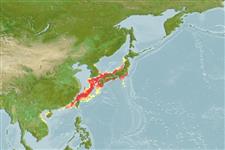Classification / Names
Noms communs | Synonymes | Catalog of Fishes(Genre, Espèce) | ITIS | CoL | WoRMS | Cloffa
>
Gobiiformes (Gobies) >
Gobiidae (Gobies) > Gobiinae
Etymology: Obliquogobius: Latin, obliquus = having slating direction or position + Latin, gobius = gudgeon (Ref. 45335); yamadai: Named for Umeyoshi Yamada, for his great contribution to our knowledge of fishes in the East China Sea.
Eponymy: Umeyoshi Yamada worked at the Fisheries Agency of Seikai National Fisheries Research Institute. [...] (Ref. 128868), visit book page.
Environment: milieu / climate zone / profondeur / distribution range
Écologie
marin démersal; profondeur 99 - 165 m (Ref. 75138). Temperate
Northwest Pacific: East China Sea and Japan.
Taille / Poids / Âge
Maturité: Lm ? range ? - ? cm
Max length : 5.2 cm SL mâle / non sexé; (Ref. 75138); 5.3 cm SL (female)
Description synthétique
Clés d'identification | Morphologie | Morphométrie
Épines dorsales (Total) : 7; Rayons mous dorsaux (Total) : 9; Épines anales: 1; Rayons mous anaux: 9; Vertèbres: 26. This species is distinct from its congeners in having the following characters: second dorsal-fin rays I, 9-10 (almost always I, 9); anal-fin rays I, 9-10 (almost always I, 9); scaled cheek and pectoral-fin base; asymmetrical caudal fin, with fifth or sixth segmented ray slightly elongate and longest; head length (HL), 28.8-33.5% of SL; eye diameter 32.7-37.3% HL, 9.6-12.3% of SL; grayish body with about 7 narrow, transverse yellow bars (pale in preservation); absence of distinct black-and-white barred pattern on caudal fin (Ref. 75138).
Body shape (shape guide): elongated.
It has been suggested that some specimens were possibly captured from sandy or sandy-mud bottoms in the center and/or western parts of Tosa Bay at the depths of 30-100 m (Ref. 75138).
Life cycle and mating behavior
Maturité | Reproduction | Frai | Œufs | Fécondité | Larves
Shibukawa, K. and Y. Aonuma, 2007. Three new species of the deep-dwelling goby genus Obliquogobius (Perciformes: Gobiidae: Gobinnae) from Japan, with comments on the limits of the genus. Bull. Natl. Mus. Nat. Sci., Ser. A, Suppl. 1:137-152. (Ref. 75138)
Statut dans la liste rouge de l'IUCN (Ref. 130435: Version 2025-1)
Menace pour l'homme
Harmless
Utilisations par l'homme
Pêcheries: sans intérêt
Outils
Articles particuliers
Télécharger en XML
Sources Internet
Estimates based on models
Phylogenetic diversity index (Réf.
82804): PD
50 = 0.5020 [Uniqueness, from 0.5 = low to 2.0 = high].
Bayesian length-weight: a=0.00955 (0.00355 - 0.02566), b=3.03 (2.80 - 3.26), in cm total length, based on LWR estimates for this (Sub)family-body shape (Ref.
93245).
Niveau trophique (Réf.
69278): 3.2 ±0.3 se; based on size and trophs of closest relatives
Résilience (Réf.
120179): Haut, temps minimum de doublement de population inférieur à 15 mois (Preliminary K or Fecundity.).
Fishing Vulnerability (Ref.
59153): Low vulnerability (10 of 100).
🛈
